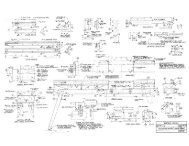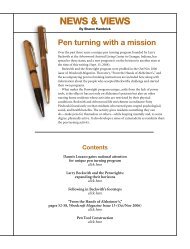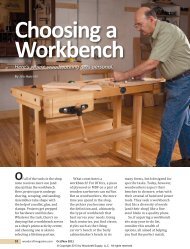42-Table Saw Safety3.indd - Woodcraft Magazine
42-Table Saw Safety3.indd - Woodcraft Magazine
42-Table Saw Safety3.indd - Woodcraft Magazine
You also want an ePaper? Increase the reach of your titles
YUMPU automatically turns print PDFs into web optimized ePapers that Google loves.
A<br />
Measure to the fence from a<br />
marked tooth, first at the front<br />
of the saw, and then at the rear.<br />
Prepare your saw<br />
In order for your saw to perform<br />
safely, the blade and fence must<br />
be properly aligned. <strong>Table</strong>saw<br />
tune-up is a story unto itself, but<br />
you can do a basic setup quickly<br />
and easily. First, align your rip<br />
fence to the blade. To check the<br />
alignment, raise the blade to<br />
full height and measure over to<br />
the fence from a marked tooth<br />
rotated forward (Photo A).<br />
Next, rotate the same tooth to<br />
the rear of the saw and measure<br />
again; then adjust your fence<br />
Riving Knives and Splitters<br />
to equalize the measurements.<br />
(Referencing from a single<br />
tooth removes any blade warp<br />
from the equation.) Some<br />
woodworkers angle the rear<br />
end of the fence away 1 ⁄ 32" or so<br />
for an extra margin of safety.<br />
Next, align your splitter or<br />
riving knife to the blade. With<br />
the blade still at full height, place<br />
an accurate straightedge against<br />
the right-hand side of the teeth<br />
(not the plate). Adjust the splitter<br />
or knife to align perfectly to the<br />
straightedge (Photo B).<br />
A riving knife or splitter is crucial for preventing kickback when<br />
ripping. Most new saws come equipped with a convenient riving<br />
knife, which rises, falls,<br />
and tilts with the blade<br />
and removes easily if<br />
necessary. Most older<br />
saws came equipped with<br />
a troublesome splitter/<br />
guard assembly that was<br />
often discarded by the<br />
user. If your saw is in the<br />
latter camp, get a splitter.<br />
A variety of aftermarket<br />
splitters are available for<br />
retrofitting to most saws (I<br />
A zero-clearance throat plate can<br />
easily be outfitted with a shop-made<br />
splitter of wood or aluminum angle.<br />
B<br />
Using a straightedge, align the<br />
splitter (or riving knife) to the righthand<br />
sides of the blade teeth.<br />
use the Biesemeyer model).<br />
Alternatively, you can make<br />
your own, fitting it to a<br />
zero-clearance throat plate.<br />
Cardinal<br />
Safety Rules<br />
If you read nothing else, read<br />
this. Some rules can be bent,<br />
others are made to be broken,<br />
but disobeying one of these<br />
may earn you a trip to the ER.<br />
• Do not wear loose clothing<br />
or jewelry at the saw,<br />
and tie back long hair.<br />
• Always wear eye and<br />
ear protection.<br />
• Never put your body<br />
or hands in front of the<br />
blade or behind it.<br />
• Don’t saw when drunk,<br />
drugged, tired or even<br />
distracted at the saw.<br />
• For general sawing, adjust<br />
the blade to project no<br />
more than about 3 ⁄8"<br />
above the workpiece.<br />
• When ripping, use a<br />
pushstick to keep your<br />
hands a safe distance<br />
from the blade.<br />
• Do not rip without using<br />
a riving knife, splitter,<br />
featherboard, or other<br />
device to keep the<br />
workpiece against the<br />
fence throughout the cut.<br />
• Never cut freehand<br />
without a fence, miter<br />
gauge, or other guide,<br />
and never grab the offcut<br />
while it’s being sawn.<br />
• If you suspect that a<br />
particular operation may<br />
be unsafe, it probably is. If<br />
you can’t provide for safety<br />
measures at the tablesaw,<br />
use a different tool.<br />
Photos: Paul Anthony Aug/Sept 2011 woodcraftmagazine.com 39










